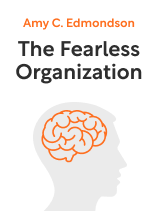

This article is an excerpt from the Shortform book guide to "The Fearless Organization" by Amy C. Edmondson. Shortform has the world's best summaries and analyses of books you should be reading.
Like this article? Sign up for a free trial here.
Do you have the potential to become a leader at work? What does it take to be a role model for your co-workers?
Managers are typically expected to create healthy work environments, but employees can contribute as well. In The Fearless Organization, Amy C. Edmondson says that despite what your role is at work, you too can make a difference.
Here’s how to become a leader at work by making co-workers feel psychologically safe.
Building Safety From the Bottom Up
What if you’re an employee and don’t have the power to change the climate of your organization from the top down?
Edmondson says that even if you’re not the boss, you can learn how to become a leader at work by creating psychologically safe spaces for your coworkers. Follow these strategies below to do just that:
- Asking colleagues questions from a place of curiosity and actively listening to their responses. Asking coworkers about challenges they face or ways you can help them lets them know that they can share ideas and concerns—and be themselves—with you.
- Showing your vulnerability when you make mistakes or don’t know something, apologizing when you’re wrong, and asking others for help—which gives others permission to do the same.
- Acknowledging shared challenges or moments of uncertainty that you and your team confront. Recognizing a shared experience where answers are unknown strengthens your bond and communicates that it’s okay not to know everything.
Edmondson also recommends these strategies if you find yourself working with a manager who is unwilling or unable to change. Although you can’t force them (or anyone) to change, you may be able to influence their behavior and buy yourself some goodwill by modeling genuine curiosity about their experience, showing compassion for challenges they face, and demonstrating your dedication to your work.
How to Be a Leader
In The Leadership Challenge, James M. Kouzes and Barry Z. Posner argue that anyone can be an effective leader because leaders are made, not born. They say that leadership is both a relationship and a developable skill that anyone can learn if they simply practice it. Around the world, people most commonly identify leaders as people who are:
- Honest
- Competent
- Inspiring
- Forward-thinking
In other words, people want to follow others whom they trust and who know what they’re doing, are positive, and have a strong sense of direction.
Further, people often identify leadership role models as local figures—their teacher, religious leader, or a family member—not stars or distant figureheads whom they don’t personally know. So even if you work in an organization where psychological safety doesn’t exist and you’re not empowered to build that culture across the company, there’s a good chance that colleagues will see you as a leader if you create pockets of psychological safety for them.
To practice being a leader at work:
- Be clear about, share, and model your values. For example, choose language that emphasizes a belief in the importance of collaboration by using words like “colleagues” and “team members,” not “boss” or “line workers.”
- Bring people on board with your vision. Talk about the things you’re passionate about and why they’re meaningful, and solicit teammates’ ideas and thoughts about them.
- Don’t accept the status quo as a fixed condition. Question ideas and systems that you think don’t work to create space for learning and growth.
- Empower and recognize others. Build colleagues’ sense of confidence and competence by highlighting and celebrating their strengths and victories.

———End of Preview———
Like what you just read? Read the rest of the world's best book summary and analysis of Amy C. Edmondson's "The Fearless Organization" at Shortform.
Here's what you'll find in our full The Fearless Organization summary:
- The importance of psychological safety in the workplace
- How leaders and non-leaders can foster psychologically safe environments
- Why workers should be able to make mistakes without fear of reprisal






